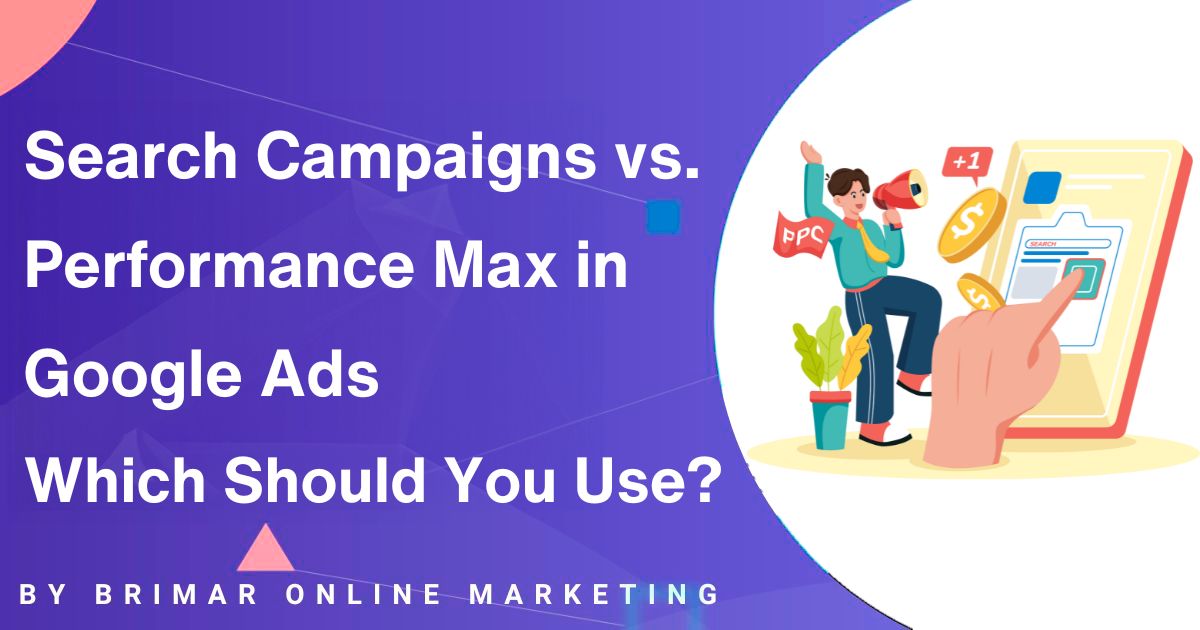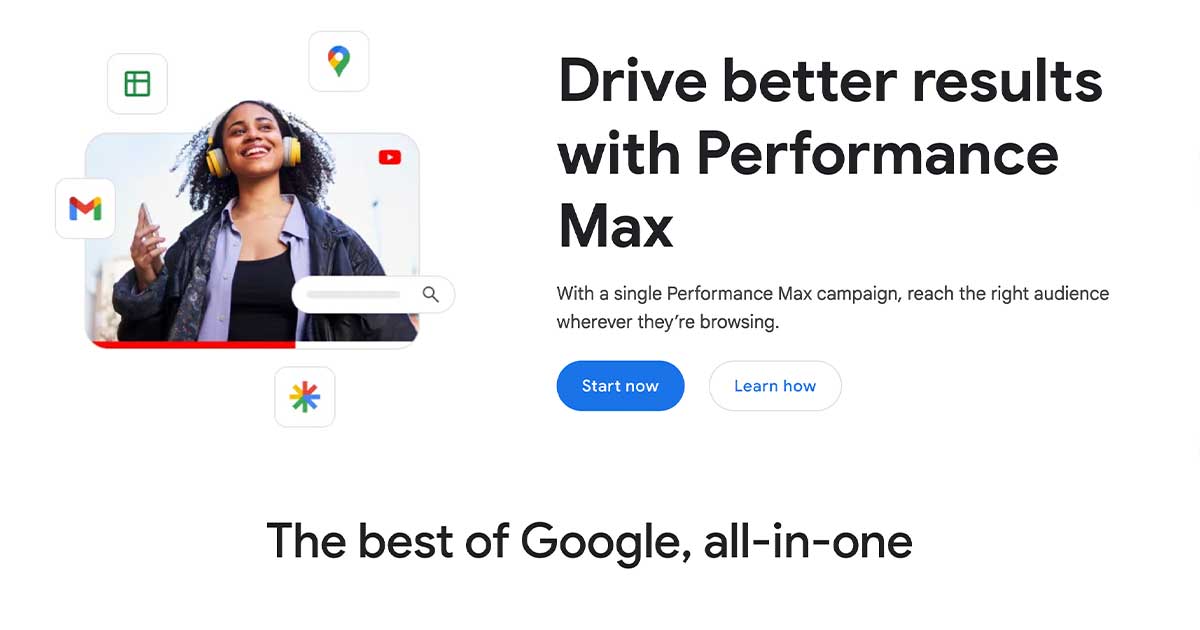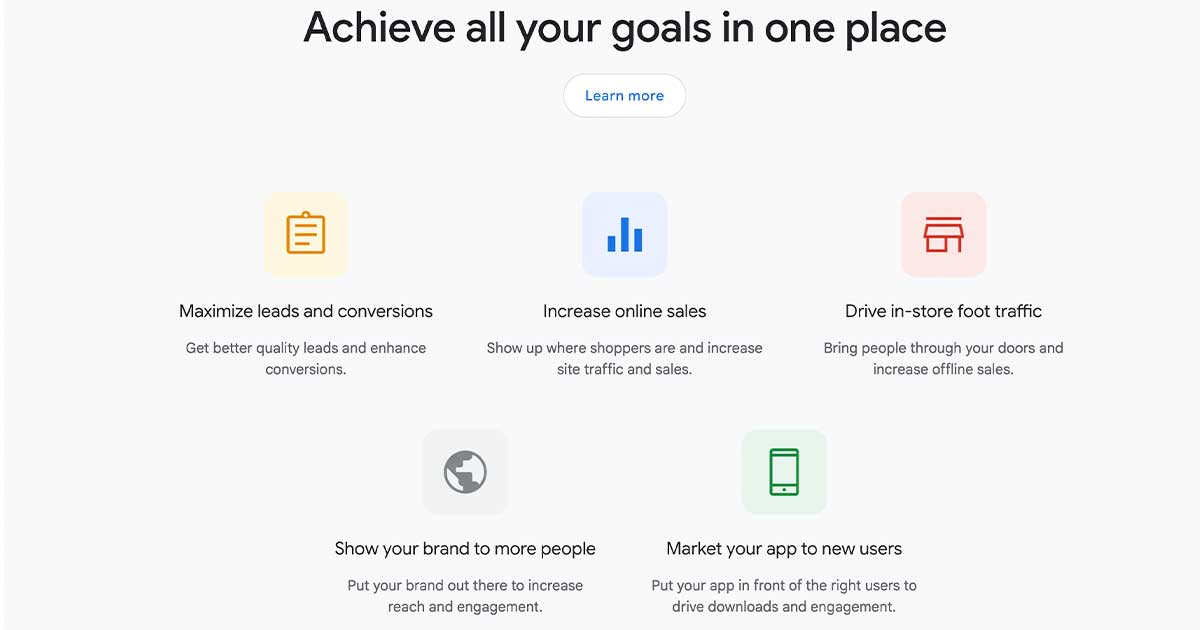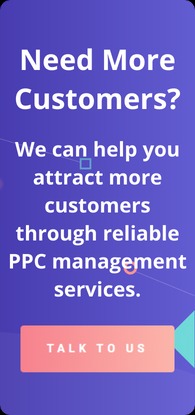
If you’re running Google Ads or thinking about starting, there’s a good chance you’ve already come across two popular campaign types: Search Campaigns and Performance Max.
And if you’re wondering which one to choose, you’re not alone.
This guide is designed for small business owners, marketers setting up a new Google Ads account, or anyone looking to allocate their ad dollars for optimal results.
Choosing the right campaign type isn’t just a technical decision; it shapes how far your budget goes, how well you reach your target audience, and how strong your conversion rates can be.
Some campaigns give you more control.
Some rely on Google’s AI for the more demanding tasks.
Knowing which approach best fits your goals, time, and resources is key.
Let’s simplify it so you can choose wisely.
What Are Google Search Campaigns?
Search campaigns are built around a straightforward idea: show your ads when someone types a specific keyword into Google.
If someone searches for “best running shoes for flat feet” and you’re selling them, you want your ad to show up in those results.
That’s precisely what search campaigns do.
These campaigns run on keywords you choose.
You build ad groups around related terms, write ads tailored to those searches, and send people to relevant landing pages.
You’re reaching high-intent traffic, people actively looking for what you offer.
Search campaigns enable you to delve into search term data, refine your ad copy, and tailor your landing pages to match what your audience is seeking.
You can also add negative keywords, so your ads don’t show for unrelated searches that waste your budget.
One of the biggest strengths?
Control.
You decide when and where your ads appear, what they say, and who sees them.
That’s a big deal if you’re working with a limited budget and need every click to count.
Search campaigns are all about precision targeting, clear insights, and the ability to optimize over time.
If you prefer steering the ship and having visibility into what’s working, this campaign type may be your best starting point.
Start Attracting Customers Through PPC Advertising Today!
We can help you create PPC campaigns that attract customers. Our services include bid management, keyword management, landing page performance reviews, and more.
What Is Google Performance Max (PMax)?
Performance Max is Google’s newer campaign type designed to simplify the ad process while expanding your reach.
Instead of focusing on specific keywords, you give Google your business goals, a set of creative assets, and audience signals, then let its AI take the wheel.
That means one campaign can now run across all of Google’s platforms: Search, YouTube, Gmail, Discover, Maps, and Display.
It pulls from your asset groups (think headlines, videos, images, and product feed) to build and test combinations, all in real-time.
This helps create relevant ads that show up where your potential customers are most active.
The upside?
You gain access to more inventory and users without creating multiple campaigns.
It’s beneficial for brands with a larger budget, multiple products, or anyone trying to reach new customers across different channels without spending hours adjusting campaign settings.
The trade-off?
You’re giving up some control, especially regarding search term data.
You won’t always know exactly which search terms triggered your ads, which can make optimization trickier.
However, it can be a powerful tool for advertisers who prioritize results over micromanaging every keyword.
Key Differences Between Search and Performance Max

Control vs. Automation
Search campaigns are all about precision.
You choose the keywords, you write the ads, you control where the money goes.
Performance Max takes a different route.
You set the destination (your campaign goals), and Google’s AI maps the journey.
This includes selecting placements, combining and optimizing creatives, and automatically managing bids.
Channels
Search campaigns display your ads exclusively in Google’s search results.
That’s it.
It’s a focused approach that is ideal for targeting individuals who are actively seeking something.
Performance Max spreads your ads across multiple platforms: YouTube, Display, Gmail, Maps, and Shopping.
It’s built to reach your audience wherever they are, not just when they’re searching.
Ad Placements & Targeting
Search relies on specific keywords, ad groups, and tight targeting.
You tell Google exactly who you want to reach and with what message.
PMax is more flexible.
You provide it with creative assets and audience signals (such as interests or past behaviors), and it determines who might be interested.
Then it tests combinations using machine learning to find what works best.
Data & Transparency
If you like digging into reports and tweaking based on search term data, Search campaigns give you that freedom.
You’ll see what people searched, which terms triggered your ads, and how each keyword performed.
Performance Max limits that kind of insight.
You won’t get detailed keyword-level data, and there’s less room to fine-tune things.
For some, that’s frustrating.
For others, it’s a relief.
When to Use Each One
Search is a better fit if you need complete control, want to target high-intent searchers, or are working with a limited budget.
It’s ideal for lead generation, local services, and any campaign where precision is crucial.
Performance Max makes more sense when your broader goals include online sales, product promotions, or brand discovery.
If you’re launching something new or want to tap into multiple Google channels quickly, PMax can deliver scale and automation with minimal setup.
Each has its place.
The best choice depends on what you’re trying to achieve and how hands-on you want to be.
Which Delivers Better Results?
Let’s get straight to the point: results matter.
Whether you’re trying to generate leads or drive online sales, you care about performance.
- How many clicks turned into real customers?
- How much did you pay for those conversions?
- When it comes to conversion rates, Search Campaigns often have the edge.
Why?
Because they’re built around high-intent keywords.
These are the terms people type in when they’re ready to take action, like “buy hiking boots online” or “SEO agency near me.”
If your ad shows up at the right moment with the right message, you’re already halfway to the sale.
On average, Search Campaigns bring in conversion rates ranging from 4% to 6%, depending on the industry and the campaign’s setup.
Performance Max Campaigns (PMax) tend to fall within the 2% to 4% range, but they compensate for this with increased volume and reach.
You’re reaching multiple channels simultaneously, which means more viewers and broader exposure.
Now, here’s where it gets interesting.
PMax shines when you’re not relying on keywords but want to lean into Google’s AI to find new customers you might not reach otherwise.
Suppose you have a product feed and multiple creative assets, and you’re targeting various campaign goals.
In that case, PMax can deliver solid results, especially in ecommerce, where image-based ads and broad placements can trigger impulse buys.
However, if you’re a local service provider, operating on a limited budget, or aiming to maximize every dollar with precise targeting, Search Campaigns are typically the better fit.
They work great for lead generation, and when paired with optimized landing pages, they can help lower your average CPC while boosting your conversion value.
Bottom line: if you need high-converting traffic, Search is the go-to.
For those looking to broaden their reach and allow Google some flexibility, PMax may pleasantly surprise you.
Pros and Cons of Each
Google Search Campaigns
Pros
- You get full control over your ads.
- You choose the specific terms, define the target audience, and block what’s not working with negative keywords.
- Ideal for store visits, lead gen, or campaigns running on a tight budget.
- You only pay when someone is actively searching for what you offer.
Cons
- They take work.
- Setting up and managing a Search campaign means knowing your way around search term data, tweaking ad copy, and constantly checking performance.
- It’s a better fit for someone who’s done this before or has the time to learn.
Performance Max Campaigns
Pros
- Tap into the power of Google AI and let smart bidding do the heavy lifting.
- PMax distributes your ads across multiple channels, from display to YouTube, allowing you to reach more people with less manual effort.
- Great for novice users or brands looking to scale without diving deep into keyword strategy.
- Just upload strong creative assets, set your conversion goals, and let it run.
Cons
- You give up some control.
- It’s harder to see exactly which search terms are driving results.
- If you need to fine-tune your messaging or cut waste, that can get tricky.
- Not the best choice if your campaign depends on specific case targeting or high-intent keywords.
Each option has its place.
The key is understanding your business goals and the level of control you want over your ad performance.
Sometimes, running both makes sense, using Search for the high-intent buyers and PMax to attract fresh prospects you haven’t thought of yet.
Best Practices for Getting the Best Results

There’s no magic button in Google Ads, but there are smart moves that consistently bring better results.
Whether you’re running a traditional Search Campaign or giving Performance Max a shot, the way you set things up and what you keep an eye on can make a big difference.
If you’re using Search Campaigns, start with the foundation: your keywords.
Select terms that your target customers are looking for.
Not broad phrases.
Not buzzwords.
Just simple, specific keywords that match what your audience types when they’re ready to act.
Once you’ve identified your keywords, write ad copy that speaks directly to your target customers.
Be clear.
Be real.
Show them you understand what they need.
Whatever you do, ensure that the landing page you’re sending them delivers on the promise made in your ad.
Relevance matters.
A lot.
Also, don’t forget about structure.
Keep your ad groups tightly themed.
If someone’s searching for one thing, don’t confuse them with unrelated offers or messages.
The more focused you are, the better your conversion rates.
If you’re testing Performance Max, think of it as setting the stage for Google’s AI to perform.
But it still needs your direction.
Start by uploading strong creative assets, images, headlines, and descriptions that reflect your brand and speak to your audience.
Blurry photos or generic messaging won’t cut it.
Next, clarify your conversion goals.
- Do you want leads?
- Purchases?
- Phone calls?
The more specific you are, the easier it is for the system to assist you in achieving those targets.
Use audience signals wisely.
These aren’t hard and fast rules but helpful hints on where to look.
Tell the system who you want to reach and why.
Then, fine-tune your asset groups.
Each group should focus on a different angle, product, or message.
Even with Google’s machine learning doing the heavy lifting, you’re still in charge.
Check your campaign settings regularly.
Watch the performance closely.
If something’s not working, tweak it.
Your results are only as good as what you feed into the system.
When Should You Use Each Type?

You don’t have to pick a favorite right away.
But knowing when to choose one over the other can help you avoid wasting ad dollars and time.
Opt for Search Campaigns if you’re the type of marketer who wants more control.
You get to decide which search terms trigger your ads, which keywords to avoid, how to organize your ad groups, and where your budget goes.
If you aim to attract individuals who are actively searching for a solution and have strong intent, this is your lane.
Search is also your best bet when you’re working with a limited budget.
You can target only the most relevant search terms, trim the fat, and focus your efforts where they matter most.
Performance Max is better when you want to cast a wider net without micromanaging every detail.
It’s great for e-commerce, especially if you’ve got a solid product feed ready to go.
Instead of building separate campaigns for Search, Display, YouTube, Gmail, and so on, you launch one single campaign, and Google handles the distribution.
It’s also useful when you want to reach new audiences fast, without managing dozens of moving parts.
The setup takes less time, and Google’s AI learns as it goes.
So, ask yourself: do you need control or convenience?
Specific targeting or broad reach?
There’s no wrong answer.
It all depends on what you’re selling, who you’re trying to reach, and how much time and money you can put into the process.
Can You Use Both Together?
Absolutely.
You aren’t required to choose a side here.
Running Search and Performance Max campaigns simultaneously can be smart, especially if you want to cover more ground without overextending your team.
Think of Search campaigns as your laser-focused tool.
You use them when you’re going after people who already know what they’re looking for.
These individuals are typing in high-intent keywords, indicating they are ready to take action.
You want to be there at the top of those Google search results with relevant ads and a landing page that seals the deal.
Performance Max, on the other hand, is more like your outreach team.
It’s great for getting your brand in front of new audiences across various Google channels, including YouTube, Gmail, Maps, and the Display Network.
It casts a wider net and helps you connect with people who might not be actively searching but are still a good fit for what you offer.
But here’s the trick: don’t let them step on each other’s toes.
You’ll want to define clear campaign goals for each.
Search should be tuned to drive high-intent traffic and direct conversions.
PMax can support discovery, retargeting, and long-term lead nurturing.
Split your budget with intention, monitor performance closely, and adjust as needed.
When done right, they can complement each other beautifully.
Final Thoughts
Choosing between Search campaigns and Performance Max isn’t about picking a winner.
It’s about understanding which tool is right for the task.
Search campaigns give you more control.
You decide on the keywords, message, and audience.
Perfect if you’re targeting specific terms and want every click to count.
Performance Max takes a different approach.
It leverages Google’s AI to reach people across multiple platforms, utilizing smart bidding, creative assets, and machine learning.
Great for expanding your reach, especially when aiming to attract new customers or work with a broader audience.
At the end of the day, it all comes down to your marketing goals, how much time you can dedicate to managing your campaigns, and what kind of budget you’re working with.
There’s real value in testing both.
Run them side by side.
Look at the data.
Track what’s working, what’s not, and refine as you go.
Sometimes the best way to find the right path is to walk both for a while.
The sooner you start, the faster you’ll see what brings the best results for your business, and that can mean more potential customers, better conversion rates, and fewer wasted ad dollars.
Our PPC Services Have Helped Our Clients Increase Their Revenue!
“I highly recommend Brimar if your looking to grow your online business. You will be satisfied with the high level of expertise and high quality of services. It has helped my business grow by leaps and bounds.”
CEO
